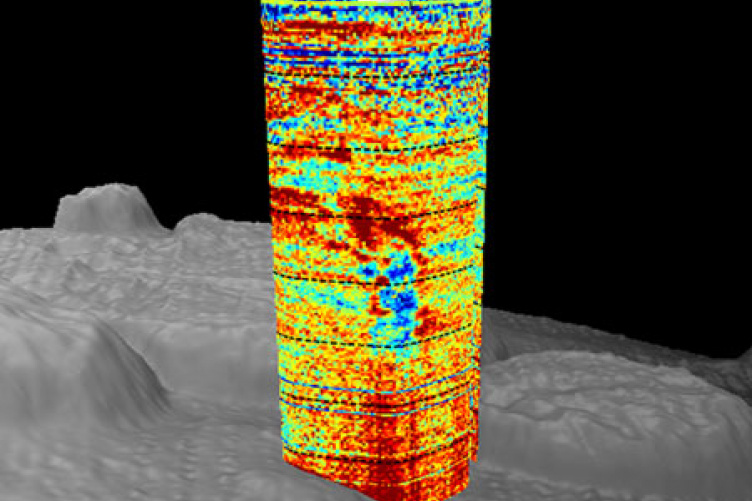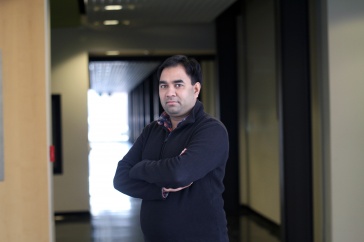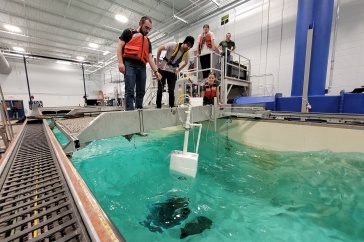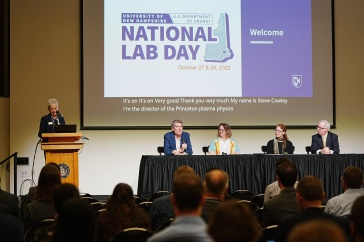
Acoustic backscatter suggesting a small amount of gas is seeping from the wellhead
Among the many lessons learned from the Deepwater Horizon oil spill in 2010, two stand out to UNH researchers Larry Mayer and Tom Weber. First and foremost, they confirmed that technology used to map the seafloor can effectively detect seeps of gas in the water column, findings that were reported in a recent special edition of the journal Proceedings of the National Academies of Science (PNAS) on the spill.
Mayer and Weber, director and assistant professor, respectively, in UNH’s Center for Coastal and Ocean Mapping, were co-authors on a PNAS article that described the various approaches – theirs among them – that aimed to determine the integrity of safely shutting the Macondo Well. There was a concern, they say, that if the well was capped, high pressure could force oil or gas to leak out elsewhere along the well casing.
“The great fear was once you have that uncontrolled release, you really have no means of stopping it until the relief well is drilled or the oil reservoir is drained,” Mayer says.
The second lesson from the disaster? “I learned to make sure you have a Nobel Laureate in physics as a Secretary of Energy,” Mayer says. Only slightly joking, he and Weber discuss with deep respect the multiple daily conference calls they had with Steven Chu while scientists, engineers and oil industry personnel scrambled to mitigate the effects of the spill. More than once, Chu’s on-the-fly calculations directed the success of the operation.
“There I was, estimating how well we could do with split aperture sonar aboard the ship while the Secretary of Energy was doing the same thing on land,” says Weber, who calls his involvement a career highlight.
Mayer and Weber, along with article lead author Stephen Hickman of the U.S. Geological Service and others, formed a Well Integrity Team in the summer of 2010 to make recommendations to the government on the safe shutting of the Macondo Well. Weber, on board the NOAA ship Pisces in the Gulf of Mexico, was evaluating the use of sonar to acoustically map any gas that might be emanating from the seafloor in the area surrounding the wellhead.
Although this use of sonar was untested, Weber detected a tiny leak from an old wellhead several kilometers from the Macondo Well. “Gas bubbles are mechanically resonant,” Weber says. “We send out a pulse of sound and they ring like a bell. They’re very easy to detect.”
Still, Mayer says, when Chu asked if he and Weber could guarantee that they would see gas seeps after the well was capped “it was the scariest question I was ever asked.”
In the end, the UNH sonar data, along with other monitoring methods outlined in the PNAS article, showed that the Macondo Well was not leaking after it was shut in. The well remained safely shut, and UNH researchers added another method to the sonar toolbox.
“It’s an example of how technology developed for one purpose, if you’re flexible enough, can be turned to another,” says Mayer.
Working around the clock to mitigate the effects of the oil spill, Weber and Mayer call the experience intense but applaud the unprecedented collaboration among scientists, engineers, emergency responders, and government officials – especially those at the top.
“I’ll never diminish the importance of the Secretary in playing the role of not just a politician but as a hard-nosed scientist,” Mayer says.
The article co-authored by Mayer and Weber, “Scientific basis for safely shutting in the Macondo Well after the April 20, 2010 Deepwater Horizon blowout,” is available here: http://www.pnas.org/content/109/50/20268.full. It ran in a special edition of PNAS that explored the multidisciplinary scientific information that guided oil spill response efforts; the issue includes an earlier paper by Weber and Mayer. The full feature is available here: http://www.pnas.org/content/109/50.toc#ScienceApplicationsintheDeepwater....
Originally published by:
UNH Today



















































